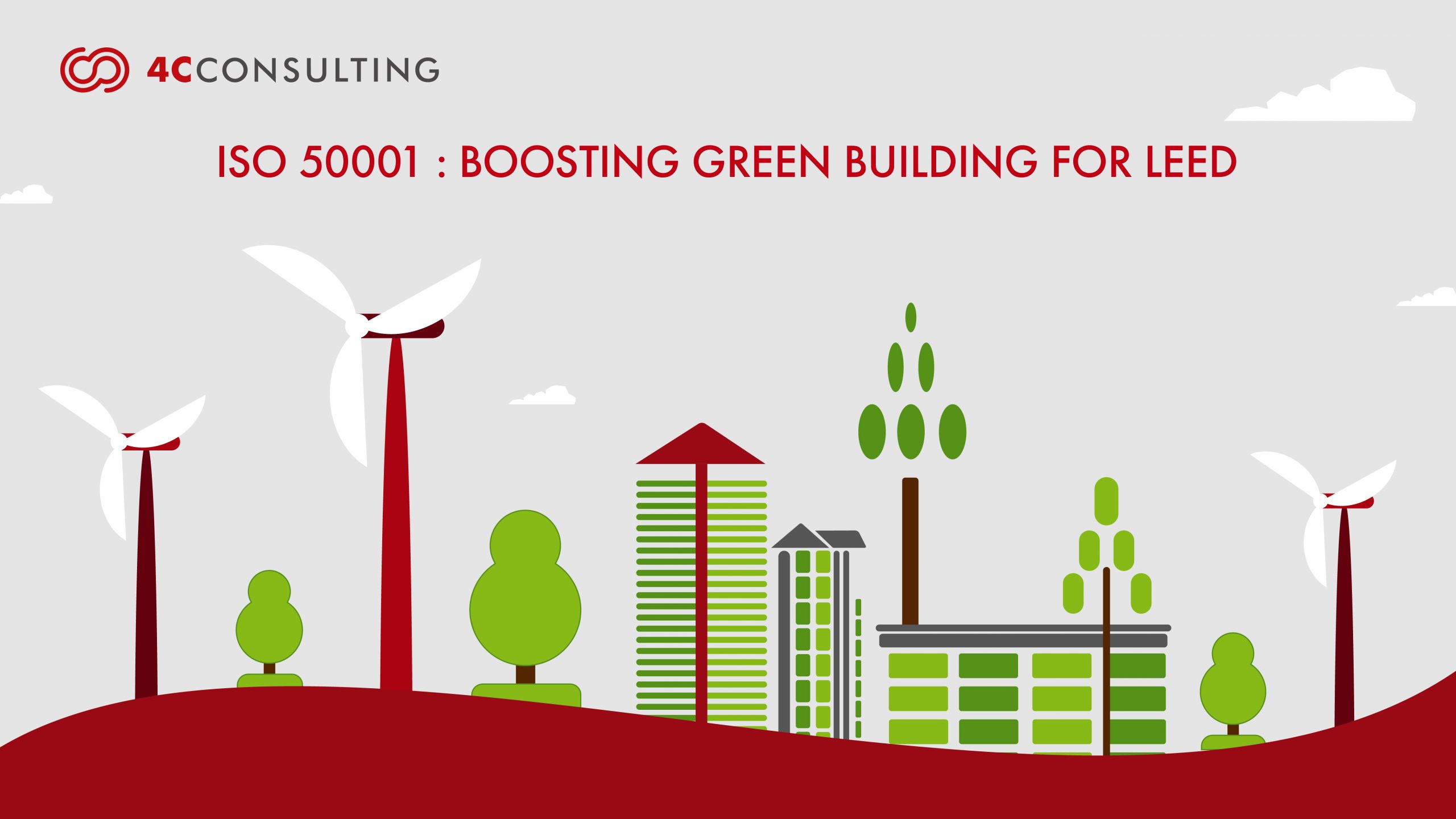
ISO 50001 CERTIFICATION: BOOSTING GREEN BUILDING EFFICIENCY FOR LEED CERTIFICATION
26th Sep, 2024
Did you know that buildings contribute nearly 40% of global energy-related emissions? As the demand for green building initiatives continues to rise, energy efficiency has become crucial for organizations to meet sustainability goals. One of the most effective tools for improving energy management in buildings is ISO 50001 certification. This certification provides a structured framework for optimizing energy use and plays a critical role in helping buildings meet LEED certification requirements. In this blog, we’ll explore how ISO 50001 certification enhances energy performance, supports green building strategies, and aligns with LEED certification standards.
.
WHAT ISO 50001 Certification?
ISO 50001 is an international standard focused on establishing Energy Management Systems (EnMS) to help organizations reduce energy consumption, improve efficiency, and lower greenhouse gas emissions. ISO 50001 enables businesses and institutions to manage their energy use more effectively, resulting in reduced costs and better environmental performance. By following a structured approach to continuous energy improvement, ISO 50001 ensures that organizations can optimize their energy consumption and sustain improvements over time. ISO 50001 is applicable to any organization, but it is particularly valuable for green buildings due to its emphasis on energy efficiency and sustainability. This standard helps buildings implement processes that improve energy management, reduce environmental impact, and contribute to the overall goals of sustainability, making it a key enabler for LEED certification.
Drive Energy Efficiency and LEED Compliance with ISO 50001
THE ROLE OF ISO 50001 IN GREEN BUILDINGS AND LEED CERTIFICATION:
ISO 50001 certification plays a crucial role in helping buildings optimize energy use while aligning with LEED certification requirements. For green building projects, navigating energy management and sustainability can be complex, and ISO 50001 provides a structured framework to ensure these goals are met effectively. Whether a building is working towards LEED certification for the first time or seeking to improve an existing Energy Management System (EnMS), ISO 50001 offers essential tools for improving energy efficiency and achieving sustainability targets it enhances green building efficiency and supports LEED certification by
- Energy Optimization: ISO 50001 provides a clear framework for continuously monitoring and optimizing energy use. This ensures that buildings operate at peak efficiency, reducing waste and lowering energy costs.
- Alignment with LEED Standards: This standard helps buildings meet the LEED Energy & Atmosphere credits by improving energy performance. This directly contributes to earning more points towards LEED certification, making it easier for buildings to achieve their sustainability goals.
- Supporting Sustainability Goals: ISO 50001-certified buildings are better equipped to reduce their carbon footprint. By optimizing energy use, these buildings contribute to broader sustainability efforts, a critical aspect of LEED certification.
- Consistency in Energy Management: Certification provides a structured approach to managing energy across all building operations. This ensures that energy management practices are consistent, which supports long-term efficiency and sustainability.
- Risk Reduction: Implementing ISO 50001 allows buildings to proactively identify and address energy inefficiencies. This helps to mitigate risks associated with energy waste, equipment malfunctions, or operational disruptions, ensuring smoother building operations.
- Renewable Energy Integration: It encourages the integration of renewable energy sources, such as solar and wind power. This not only reduces reliance on non-renewable resources but also helps buildings earn additional LEED points for sustainability efforts.
- Data-Driven Decision Making: ISO 50001 emphasizes the importance of using data analytics to track energy performance. This enables buildings to make informed, data-driven decisions that continually improve energy efficiency and enhance overall building performance.
.
STEPS FOR ISO 50001 CERTIFICATION IN GREEN BUILDING PROJECTS
ISO 50001 certification involves a series of structured steps designed to integrate energy management systems into green building practices. These steps are:
- Conduct an Energy Review and Establish a Baseline: The first step is to perform a comprehensive energy audit to evaluate the building’s current energy use and identify inefficiencies. This audit provides critical data that will serve as the building’s energy baseline, helping to track energy consumption and highlight areas for improvement. Establishing a baseline is essential for setting realistic, measurable energy performance targets aligned with both ISO 50001 and LEED certification requirements.
- Set Energy Performance Objectives: Once the baseline is set, the next step is to define clear and measurable energy performance objectives. These objectives should focus on improving energy efficiency, reducing energy consumption, and integrating renewable energy sources. Align these goals with the LEED Energy & Atmosphere credits to ensure the building meets LEED energy performance standards while driving sustainability.
- Develop an Energy Management System (EnMS): A key requirement for ISO 50001 certification is the creation of an Energy Management System (EnMS). This system outlines the processes, procedures, and responsibilities required to optimize energy use within the building. It includes strategies for energy monitoring, energy-saving initiatives, and implementing best practices. The EnMS ensures that all energy-related activities are well-documented and aligned with both ISO 50001 and LEED certification standards.
- Implement the EnMS: After developing the EnMS, it’s time to implement the system. This involves deploying energy-efficient technologies such as smart meters, IoT devices, and automated energy control systems that provide real-time data on energy consumption. The implementation phase also includes training staff on energy-saving practices and ensuring that all stakeholders understand the energy management goals. This step ensures that the energy performance objectives are met and maintained.
- Certification Audit and Continuous Improvement: The final step in theISO 50001 process is the external audit, conducted by a certified third-party organization. The audit will assess the building’s EnMS and determine whether it complies with ISO 50001 standards. Once the certification is obtained, the focus shifts to continuous improvement, where the building continuously monitors and evaluates its energy performance to ensure ongoing compliance with ISO 50001 and LEED certification standards.
.
Benefits of ISO 50001 for Green Buildings and LEED Certification
Achieving ISO 50001 certification offers significant benefits to green buildings, particularly in terms of energy efficiency and LEED certification compliance and 5 major benefits are:
- Cost Savings: One of the most immediate benefits of ISO 50001 certification is the reduction in operational costs. By optimizing energy use, green buildings can lower their energy bills, leading to significant cost savings over time. This is particularly valuable for large-scale projects that consume substantial energy resources.
- Environmental Impact: ISO 50001 certification helps green buildings reduce their carbon footprint by improving energy efficiency and reducing greenhouse gas emissions. This aligns with global climate goals and ensures that buildings contribute to the fight against climate change, making them more sustainable and environmentally responsible.
- Improved LEED Certification Scores: By implementing ISO 50001, buildings can easily meet or exceed the LEED Energy & Atmosphere requirements, which improves their overall LEED score. This makes it easier for developers to achieve LEED certification and enhances the building’s sustainability credentials in the marketplace.
- Increased Property Value and Marketability: ISO 50001-certified buildings are more attractive to eco-conscious tenants and investors. The certification signals a commitment to sustainability and energy efficiency, which increases the building’s market value and boosts occupancy rates. This is especially beneficial for developers aiming to position their properties as eco-friendly.
- Long-Term Energy Efficiency: ISO 50001 emphasizes continuous improvement, ensuring that green buildings maintain high levels of energy efficiency long after certification. This reduces the need for costly retrofits and ensures that the building remains sustainable, energy-efficient, and LEED-compliant for years to come.
Incorporating ISO 50001 certification into green building projects is a powerful strategy for improving energy efficiency, reducing costs, and achieving LEED certification. ISO 50001 provides a structured framework for optimizing energy use and ensures continuous improvement in energy performance. By aligning with both ISO 50001 and LEED standards, green buildings can enhance their sustainability, reduce their environmental impact, and gain a competitive edge in the marketplace.
.
WHY CHOOSE 4C CONSULTING TO ENSURE A SUCCESSFUL ISO 50001 CERTIFICATION?
At 4C Consulting, we specialize in leveraging Energy Performance Indicators to facilitate ISO 50001 certification, enabling organizations to efficiently manage and improve their energy usage. Our expert team employs these indicators to assess and optimize your energy practices, ensuring alignment with ISO 50001’s Energy Management Systems standards. Through detailed analysis and tailored strategies, we help you achieve significant energy savings and gain recognition for your sustainability efforts. contact us now!
